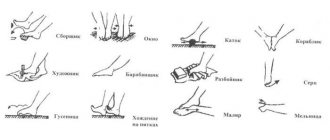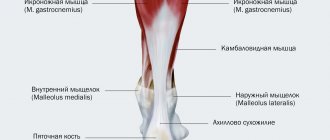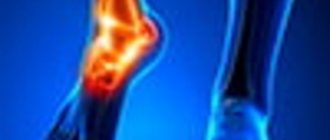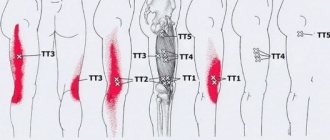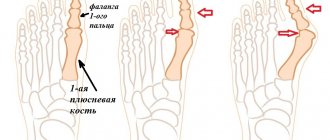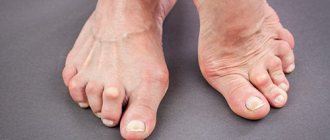Foot pain is a common reason for seeking medical help. It can be caused by damage to peripheral nerves, distal vessels, periarticular tissues, the joints themselves, bones, skin and muscles. In medical practice, a separate category is “pain syndrome” of the foot, which can cause physiological and nervous changes. Differential diagnosis for this symptom requires an integrated approach with in-depth knowledge of anatomy, since foot pain can be caused by a large number of factors. It is the correct diagnosis that allows you to subsequently select the correct treatment algorithm aimed at the causative factor.
Pain in the feet: causes
Various diseases, their complications, neoplasms and injuries can act as a cause of pain in the feet. The most common of them:
- injuries to bones, tendons, ligaments and muscles. According to statistics, bruises, sprains, dislocations and fractures in the foot and ankle joint are the most common among household and sports injuries. The mechanism of “pain syndrome” in this case is direct damage to nerve fibers or compression of nerve endings by soft tissues (due to edema). The most common injuries are the big toe, ankle ligaments, and fifth metatarsal. In sports medicine, there is even the concept of a “stress fracture,” when the integrity of one of the bones of the foot is damaged due to prolonged methodical damage of insignificant force;
- foot pain often develops against the background of flat feet. This pathological condition is characterized by the fact that when walking, the arch of the foot does not absorb steps, and the sole is completely adjacent to the floor. This creates additional stress on the osseous-ligamentous apparatus, resulting in pain in the foot;
- joint inflammation. Rheumatism, rheumatoid arthritis, psoriatic arthritis, osteoarthritis may be the reasons for severe pain in the foot area. It is caused by inflammatory processes in the synovial membranes and capsule of the foot joint, as well as increased production of intra-articular fluid;
- periarticular lesions. A whole group of conditions that includes inflammation of the ligaments, tendons and fascia. They can occur either independently or accompanying joint lesions. Heavy physical activity and uncomfortable shoes lead to the appearance of periarticular lesions;
- “diabetic foot” is a syndrome associated with pathological changes in blood vessels and nerves, which lead to irreversible damage to the skin, soft tissues, bones and joints. Sometimes the “diabetic foot” syndrome occurs in a painless form (with damage to peripheral nerves), but more often, with this pathology, the foot hurts greatly;
- ingrown nail, or onychocryptosis, is characterized by pathological ingrowth of the nail plate into the periungual fold. This is most often observed on the first toe. The trigger for its development is tight shoes and incorrect nail cutting technique;
- “heel spur” is a pathology in which bone growths are noted in the area of the heel bone. Reaching a significant size, they put pressure on soft tissues, especially during walking and physical activity;
- Gout is a systemic disease manifested by excessive accumulation of uric acid in the body. Its crystals are deposited in various organs and tissues. One of the most common places is the first metatarsophalangeal joint, in the area of which severe acute pain occurs;
- obliterating vascular diseases. Chronic arterial lesions such as atherosclerosis, endarteritis and thromboangiitis can also cause pain in the arch and toes. The reason for their appearance is the constant lack of blood circulation in this place;
- Varicose veins can lead to swelling of the leg, resulting in aching pain starting from the foot and rising to the lower leg.
In addition to the listed causes of foot pain, there are less common conditions that are also characterized by this symptom. Rare bone deformations, neoplasms of soft and hard tissues, anomalies and malformations can act as an etiological factor. There is also the concept of “physiological pain” in the foot; they appear after long walking, prolonged standing work, playing sports or doing heavy work.
Causes of pain in the bones of the legs
It has been noted that pain in a bunion on the side of the leg often bothers people after 40–45 years of age. At this age, the tissues are no longer so elastic and hardy, so the foot copes worse with shock-absorbing functions. Women face this problem more often than men, which is due to several factors: increased stress on the legs during pregnancy, hormonal changes during menopause and wearing uncomfortable shoes. Pain can be caused by:
- foot deformity;
- metabolic abnormalities;
- degenerative-dystrophic processes;
- injuries and microtraumas.
Gout attacks
With gout, the bone in the foot hurts and grows, and the shape of the big toe may also change. Due to metabolic disorders, uric acid accumulates in the body, which is deposited in the joints. Its crystals are primarily formed in the lower extremities - in the small joints of the foot, in the big toe, and less often in the knees. Because of this, the foot becomes deformed and a peculiar growth forms on the leg. Gout is characterized by attacks that usually begin at night and last 3–7 days. At this time the following are observed:
- unbearable joint pain of a pressing, cutting or tearing nature;
- temperature rise to 38 °C, and sometimes higher;
- muscle cramps, spasms;
- intoxication.
Attacks may occur after eating foods rich in purines (mainly meat and fish products) and drinking alcoholic beverages. Gradually, tophi begin to form on the skin - bumps filled with a thick whitish mass. Without treatment, gout leads to deformation and destruction of joints and damage to internal organs. An orthopedist treats this disease. Previous injuries The main reason why the bones in the legs hurt are injuries of varying severity: sprains and torn ligaments, bruises and other injuries. What to do if the bone in your foot hurts after a bruise:
- remove shoes and socks;
- apply a cold compress;
- apply a pressure bandage made of an elastic bandage;
- take a pain reliever.
These measures will help avoid swelling and reduce pain.
If pain appears after an injury, even a seemingly minor one, you need to consult a traumatologist. Without treatment, injuries lead to inflammation, joint destruction, lameness and other complications. Foot deformation Under the influence of excess weight or excessive physical activity, the feet often begin to deform, and incorrectly selected shoes accelerate this process. With flat feet and other types of deformities, the leg often hurts at the bottom, where the bone is, or closer to the instep. These disorders also cause rapid leg fatigue. In the early stages, changes in the shape of the leg can only be detected using radiography. Over time, the deformation becomes noticeable to the naked eye, the pain intensifies, and lameness appears. In the early stages, these pathologies respond well to treatment with exercise therapy, physiotherapy, wearing orthopedic shoes and proper nutrition. In the future, it becomes more and more difficult to correct the shape of the feet. Arthritis and other joint pathologies Degenerative-dystrophic diseases are another possible reason why the bone on the foot near the big toe swells and hurts. As a rule, these diseases develop after 35–40 years, but with obesity, metabolic disorders, psoriasis or repeated injuries, they can appear at a young age. Some forms of arthritis are caused by chronic infections.
Arthritis and other diseases of small joints are indicated by:
- decreased finger mobility;
- crunching, clicking when moving;
- the appearance of edema;
- constant aching pain that increases with exertion.
Articular pathologies are characterized by chronic development. The pain is felt constantly and becomes more intense over time. The cartilage tissue gradually becomes thinner, then practically disappears, due to which the joint is deformed, the shape of the foot changes, the ligamentous apparatus suffers, and inflammatory processes are possible. In the later stages, final recovery is no longer possible, but if you seek medical help in a timely manner, the chances of complete restoration of the joints are high.
Clinical picture
Foot pain can vary in nature, duration and intensity. These signs, as well as accompanying manifestations, differ from each other in cause.
| Cause | Clinical picture |
| Injury | The intensity of the pain syndrome directly depends on the strength of the traumatic injury. It can be either a slight nagging pain (after a sprain) or unbearable (after a broken bone). Often there is swelling, bruising and subcutaneous hematomas in the ankle area. |
| Flat feet | The patient begins to notice pain at the end of the working day, especially if he spent a lot of time in an upright position. Often, with this pathology, the spine also suffers, so discomfort in the back is an integral symptom of flat feet. |
| Arthritis | The pain is combined with swelling, stiffness, crunching and morning stiffness in the joint. With various types of diseases, not only the joints of the foot can suffer, but also other parts of the body, especially the shoulders, knees and elbows. Often the joints are enlarged and the skin over them appears reddened. |
| Inflammation of ligaments, tendons and fascia | The pathology manifests itself as a characteristic creaking sound during movements. More often than not, there are no external signs of the disease, but severe pain occurs when attempting to move. Deterioration is associated with physical activity. |
| Diabetic foot | In addition to the pain syndrome, dry skin, flaking of the skin, fragility and darkening of the nail plates, hair loss, and long-term non-healing wounds are characteristic. Last but not least are the main symptoms of diabetes: general weakness, fatigue, constant thirst and frequent urination. |
| Ingrown nail | Visual diagnosis, which is characterized by ingrowth of the nail plate into the nail fold. The patient is forced to see a doctor due to swelling, redness and pain in the soft tissue area of the first toe. In advanced cases, an infection occurs, causing purulent inflammation. |
| Heel spur | This condition is characterized by pain in the heel area, which intensifies when walking on a hard surface. Sharp blows, jumping or stepping significantly increase the pain. The pain is relieved by walking on a soft surface or wearing comfortable shoes. |
| Gout | An attack of pain usually occurs after a diet violation - eating red meat, wine or beer. A sharp shooting pain at the base of the first finger becomes simply a test for the patient. It is often the cause of insomnia and other psychological disorders. |
| Obliterating atherosclerosis, endarteritis and thromboangiitis | In addition to constant increasing pain, patients note a feeling of coldness in the legs, pallor of the skin and trophic skin disorders. The group of pathologies is characterized by the symptom of “intermittent claudication,” when the patient experiences pain after covering a certain distance. A few minutes of rest brings significant improvement and allows you to continue moving. |
| Varicose veins of the lower extremities | In addition to the nagging dull pain in the evening, swelling of the lower extremities and cramps of the calf muscles appear. Changes in the saphenous veins are constant - they look enlarged, deformed and filled with blood. Over time, hyperpigmentation of the skin may develop or even trophic ulcers may appear, which are very difficult to respond to conservative treatment. |
TREATMENT AND RESTORATION OF THE MUSCULOCAL SYSTEM
Causes of leg pain not related to disease:
Pain in the lower extremities (if it is short-term and irregular) can be associated not only with the disease, but also with prolonged physical stress, overwork, and most often occurs in the calf muscle. The leg muscles begin to experience oxygen starvation, and breakdown products, in particular lactic acid, cease to be excreted from them. To eliminate them, it is recommended to relax the muscles. To do this, just lie down or sit down, thereby changing the position of the limb, and strongly rub the cramped muscle with your hands.
Dull, aching and stabbing pain in the calf muscles, cramps often occur after prolonged standing or sedentary work. When, due to prolonged stagnation in the veins of the lower extremities, normal venous and arterial blood circulation does not occur, oxygen starvation occurs.
Leg pain – causes associated with various diseases:
1. Pain in the leg due to injury:
— Leg bruises are the most common injuries to the lower extremities. When a bruise occurs, the patient notes the connection between the injury and the occurrence of pain. There is swelling and hematoma (bruise) at the site of the injury. Impaired limb function depends on the location of the injury, its intensity and the volume of the damaged area.
— Fractures of the bones of the lower extremities are a violation of the integrity of the bone, and sometimes the joint. Depending on the severity of the fracture (open or closed, with or without displacement), pain in the leg muscles will have varying intensity. In addition, if the neurovascular bundle is injured, there will be signs of impaired blood supply to the leg and foot, and neurological disorders.
- Strained muscles of the lower limb can occur when jogging, fast walking, playing any active sport, and sometimes even when wearing poorly fitting shoes. The muscles look swollen, tense and heavy.
Patients complain of pain, sometimes quite pronounced, that occurs when feeling the muscles. Pain increases with movement, especially when bending the knee and ankle joint.
- Muscle ruptures. Typically, such damage is localized in a small area of the muscle, in the area of its connection with the tendon. However, in some cases, quite large ruptures may occur, sometimes even accompanied by complete separation of the muscle from the tendon. As a rule, such injuries occur when the limb is sharply bent in the direction opposite to the acting force. Muscle rupture is always accompanied by sudden severe pain in the lower limb. The pain syndrome may subside for a while, but then it always returns, the pain becomes constant and intensifies as the hematoma grows and muscle spasm develops. Such injuries are always accompanied by severe swelling in the area of the damaged muscle and a significant decrease in range of motion.
— Long-term crush syndrome (LCS, crash syndrome) of soft tissues - this peculiar pathological condition develops as a result of long-term (4-8 hours or more) crushing of soft tissues of the extremities by fragments of destroyed buildings, structures, blocks of soil during collapses in mines, etc. Crash syndrome occurs in emergency situations (earthquake, building collapse, etc.).
- Aching pain in the leg muscles with spontaneous hematomas. Sometimes patients who are treated with anticoagulants may experience sudden hemorrhages in the muscles of the lower extremities. This pathology is characterized by aching pain and an increase in the size of the affected area.
2. Pain in the leg muscles due to vascular pathologies of the lower extremities:
— Chronic arterial insufficiency of the lower extremities is accompanied by a characteristic pain syndrome that occurs when walking a limited distance (up to 500 m).
— Chronic venous disease (CVD, varicose veins) occurs as a consequence of insufficiency of the venous system. Pain in chronic venous disease is localized in the final parts of the legs, is bursting in nature and is often combined with other symptoms, such as a feeling of heat, goosebumps and tingling.
— Thrombophlebitis is an acute inflammation of the walls of a vein with the formation of a blood clot in its lumen. Symptoms depend on the location of the thrombosis. Along the course of the thrombosed vein, acute nagging pains, a local increase in temperature, skin hyperemia and a dense painful cord upon palpation occur; body temperature may rise to 37.5 - 38 ° C. The disease usually begins acutely, with pain in the calf muscles, a feeling of fullness in the lower leg, especially when lowering it down, and an increase in body temperature. The most serious complication of this disease is the risk of a blood clot breaking off from the inner walls of a venous vessel. This clot of coagulated blood can travel through the body's bloodstream and cause blockage of vital vessels.
— Lymphostasis is a congenital or acquired disease associated with a violation of the outflow of lymph from the lymphatic capillaries and peripheral lymphatic vessels of the extremities and other organs to the main lymphatic collectors and the thoracic duct. Patients complain of swelling of the lower extremities, pain, heaviness and fatigue in the limbs, and the appearance of trophic disorders on the skin.
3. Pain in the leg due to inflammatory diseases:
This is a group of combined inflammatory lesions of the muscles and ligaments of the lower extremities. These pathologies are a consequence of chronic overstrain of the leg muscles under high and intense loads, and are accompanied by microtrauma to muscles and ligaments. Additional risk factors are general fatigue, chronic diseases, hypothermia, etc. With the chronic course of these diseases and continued stress, muscle tears can occur, and sometimes they are completely torn from their attachment points.
Muscle inflammation (myositis)
manifests itself as local muscle pain, which intensifies with pressure on the muscles or with movement. This pain causes tension in the affected muscles and limits joint mobility. Sometimes myositis can manifest itself as swelling or redness of the skin in the sore spot. Also, symptoms of myositis include increasing muscle weakness, in which it becomes difficult for the patient to perform simple and familiar actions. The causes of myositis can be infectious diseases (ARVI, influenza, chronic tonsillitis), exposure to toxic substances, trauma, metabolic disorders, hypothermia, excessive muscle tension, professional activity (violinists, pianists, PC operators, drivers are at risk of developing myositis), muscle convulsions, parasites (trichinosis, cysticercosis).
4. Pain in the leg muscles with flat feet:
One of the reasons for constant pain in the muscles of the lower extremities can be flat feet. With this pathology, the arch of the foot flattens - it becomes flatter, which causes a disruption in its shock-absorbing functions. Flat feet are manifested by a feeling of “leaden” heaviness, pain in the leg muscles and rapid fatigue when walking. Also, with this pathology, the knee joints suffer greatly, since they bear most of the load. In addition, the load on the spine increases, since the body has to somehow compensate for shocks and jolts during movement. The main symptoms of flat feet are worn out and worn-out shoes on the inside; very rapid fatigue and the appearance of pain in the leg muscles when walking and staying in an upright position for a long time; heaviness in the legs, their cramps and swelling at the end of the day; swelling of the ankles; increase in foot size in width.
5. Neurological diseases and leg pain:
— Pain associated with lumbosacral osteochondrosis is localized along the back of the thigh from the buttock to the popliteal fossa, that is, along the sciatic nerve. Often these pains appear suddenly and can significantly limit the patient's motor activity. Lifting heavy objects or sudden movements of the body may act as provoking factors. It is also typical that the pain intensifies when moving or going down stairs.
— Diseases of peripheral nerves can also provoke pain in the calf muscles. With neuralgia, pain is paroxysmal in nature and occurs along the nerve fibers. In the intervals between attacks, there is practically no pain, and the painful attack itself can last from several seconds to several minutes. With Raynaud's disease, you may experience pain in your toes after they become “numb.”
6. Pain in the leg muscles due to metabolic disorders and pathology of fatty tissue:
— With some violations of the water-salt balance, patients may complain of pain and cramps in the muscles of the lower extremities. A similar condition occurs when the body is dehydrated, which is caused by prolonged diarrhea, excessive vomiting or taking diuretics. Since disturbances in water-salt balance are not an independent disease, but arise as a result of some pathology, the symptoms will be different, but the main ones are considered to be constant thirst and widespread swelling. A decrease in blood pressure, palpitations and heart rhythm disturbances are also possible.
— Pathology of subcutaneous fat tissue. Panniculitis is a progressive inflammatory lesion of subcutaneous fatty tissue, leading to the destruction of fat cells and their replacement with connective tissue with the formation of nodes, plaques or infiltrates. The main manifestation of spontaneous panniculitis is nodular formations located in the subcutaneous fatty tissue at varying depths. Most often they appear on the legs and arms. The color of the skin over such formations can be pink, burgundy or burgundy-bluish. In addition to local manifestations of panniculitis, there may also be general ones, such as weakness, malaise, loss of appetite, fever, nausea and vomiting.
- Pain in the leg muscles in obese people. The cause of pain in the muscles of the lower extremities can also be obesity. If a person is overweight, then additional stress is placed on the lower limbs and they experience increased pressure. This inevitably leads to pain in the leg muscles, especially with small feet.
Treatment of foot pain
Finding out the cause of the symptom allows for effective treatment of foot pain. Elimination of the etiological factor is the most important point in therapy and is often only sufficient to completely relieve the pain syndrome.
- Traumatic injury and periarticular inflammation require an integrated approach. In addition to analgesics, anti-inflammatory drugs, local cooling, splints, plaster casts and special orthoses can be used. Severe injuries require surgery (to restore the integrity of bones, tendons and ligaments).
- Ingrown toenails, heel spurs, and varicose veins that cause pain in the right and left foot require surgery. The type and extent of the operation depend on the form and stage of the pathological process.
- Arthritis, diabetic foot and gout require systemic maintenance therapy, the plan of which must be prescribed by an appropriate specialist. Local treatment without eliminating the cause, in this case, turns out to be ineffective.
- Obliterating arterial diseases are a complex problem (in terms of treatment approach). To eliminate them, both conservative measures and surgical intervention may be required. Delay can have very serious consequences, sometimes requiring the amputation of part of a limb.
